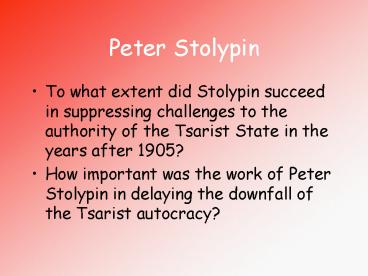Peter Stolypin - PowerPoint PPT Presentation
1 / 13
Title:
Peter Stolypin
Description:
Peter Stolypin. To what extent did Stolypin succeed in suppressing challenges to ... Stolypin's work did succeed in delaying the downfall of the Tsarist autocracy ... – PowerPoint PPT presentation
Number of Views:378
Avg rating:3.0/5.0
Title: Peter Stolypin
1
Peter Stolypin
- To what extent did Stolypin succeed in
suppressing challenges to the authority of the
Tsarist State in the years after 1905? - How important was the work of Peter Stolypin in
delaying the downfall of the Tsarist autocracy?
2
Peter Stolypin
- Appointed president of the council of Ministers
after 1905 revolution - He became Chief Minister in 1906
- Period in power was shortlived, he was
assassinated in 1911
3
suppression first and then, and only then,
reform.
- He was dedicated to strengthening tsardom
- In 1906 he faced threatened mutinies at the naval
base of Kronstadt, Sveabord and Reval as well as
a number of army units - In addition there were strikes in St Petersburg,
the SRs had embarked on a campaign of terror and
there were fears o peasant uprisings - A SR bomb blew up Stolypins house, injuring his
daughter and killing 27 people
4
What did Stolypin do about the violence?
Special military courts were set up to deal with
terrorists
Over 3,000 suspects convicted and executed
Used state violence to restore public order
Provinces were placed under martial law
5
Policy of Russification
- Stolypin was an intense Russian nationalist
therefore policy was endorsed - Policy of repression was extended to the minority
peoples of the empire e.g. Poles and Jews
- The policy brought the non-Russian parts of the
empire under control - but lost what sympathy the minorities had for the
Tsarist government
6
Stolypins solution to the lack of cooperation of
the 1st and 2nd Duma was straight forward
By reducing the franchise, it was dominated by
more conservative delegates
This meant only landowners and wealthy people
could vote
The 3rd Duma ran for its full term
He changed the electoral and fundamental laws
7
Land Reforms
- However he also believed reform should be
introduced to reduce opposition - Through his land reforms he hoped to set up a
large land owning peasantry - The peasants problems had not been solved by
emancipation in 1861 - By giving the peasants a stake in the existing
social order Stolypin hoped that the tide of
revolution would be stemmed
8
What did the reforms involve?
- Supervised enclosure movement
- A land bank provided the means by which peasants
could purchase land - Resulted in the transfer of millions of acres of
state land to peasants by means of loans at low
interest rates
9
Reasons for the failure of land reforms
- Russia was a backwards country, would take longer
than advanced countries to become effective - He spoke of needing 20 years, his assassination
only allowed him 5 and the war allowed Russia 8
years - Doubt over whether policy would have worked long
term, peasants slow to respond - By 1914 only 10 of land had been consolidated
into farms as peasants reluctant to move from
commune to individual farming read P16 of notes
10
Industrial development
Stolypin concentrated more on land reform however
he did not neglect industry, from 1908
substantial growth took place in coal, iron and
steel and railway building also proceeded
Employment was created and this partly calmed the
workers, although historians argue this was a
coincidence and had nothing to do with Stolypins
initiatives. Although problems not swept away,
his reforms did help to create a calmer climate
11
Historians views on Stolypin
- Between 1906 to 1911 Stolypin provided a
programme of evolutionary change, as L. Schapiro
commented
For his many admirers he has posthumously become
the wisest statesman that Russia ever had, who
could, had he been given time, have saved Russia
from war and revolution, and have effected a
peaceful transformation of the country on a
moderate and modern lines
12
Historians views on Stolypin
- Lynch states that his success in this regard
hinted at what might have been achieved in terms
of co-operation between government and
progressive opinion, had tsarist authorities been
willing to trust their own ministers.
- A notable feature of his land policy was his
effective working relations with the Duma
13
Summary
- Stolypins work did succeed in delaying the
downfall of the Tsarist autocracy - However it was regarded with great suspicion by
the Tsar, dismayed by the growing influence of
the Duma in state affairs
- Other factors which delayed downfall were
- Concessions by Tsar after 1905
- Loyalty of army
- Split in triple alliance and parties































